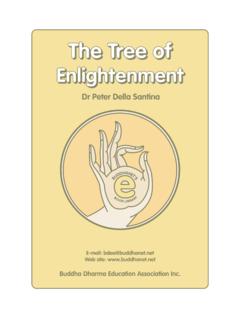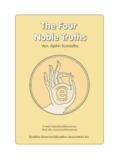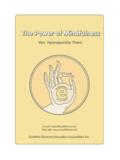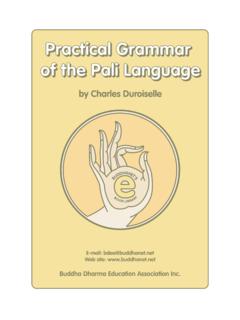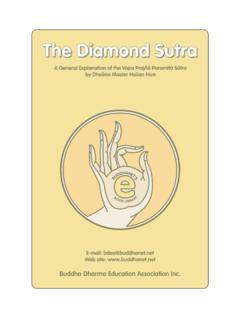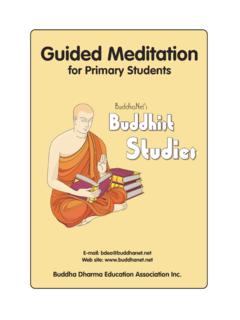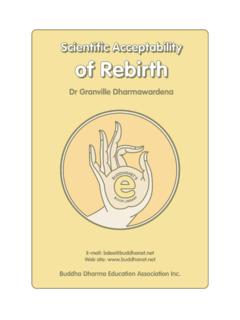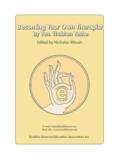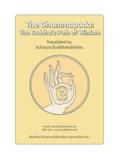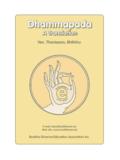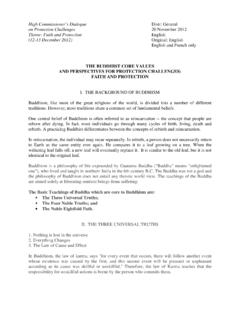Transcription of The Buddha and His Teachings
1 EBUDDHANET'SBOOKLIBRARYE-mail: site: Dharma Education Association Narada MahatheraThe Buddha and His TeachingsThe Buddha and His TeachingsThe Buddha and His TeachingsVenerable N rada Mah theraReprinted for free distribution by The Corporate Body of the Buddha Educational Foundation Taipei, Taiwan. July 1998 Namo Tassa Bhagavato Arahato Samm -SambuddhassaHomage to Him, the Exalted, the Worthy, the Fully Enlightened OneiiiContentsIntroduction .. viiThe BuddhaChapter 1 From Birth to Renunciation .. 1 Chapter 2 His Struggle for enlightenment .. 13 Chapter 3 The Buddhahood .. 25 Chapter 4 After the enlightenment .
2 33 Chapter 5 The Invitation to Expound the Dhamma .. 41 Chapter 6 Dhammacakkappavattana Sutta .. 54 Chapter 7 The Teaching of the Dhamma .. 75 Chapter 8 The Buddha and His Relatives .. 88 Chapter 9 The Buddha and His Relatives .. 103ivChapter 10 The Buddha s Chief Opponents and Supporters .. 118 Chapter 11 The Buddha s Royal Patrons .. 141 Chapter 12 The Buddha s Ministry .. 152 Chapter 13 The Buddha s Daily Routine .. 168 Chapter 14 The Buddha s Parinibb na (Death) .. 173 The DhammaChapter 15 The Teachings of The Buddha .. 201 Chapter 16 Some Salient Characteristics of Buddhism .. 223 Chapter 17 The Four Noble Truths.
3 241 Chapter 18 Kamma .. 252 Chapter 19 What is Kamma? .. 265 Chapter 20 The Working of Kamma .. 275vChapter 21 Nature of Kamma .. 293 Chapter 22 What is the Origin of Life? .. 302 Chapter 23 The Buddha on the so-called Creator-God .. 312 Chapter 24 Reasons to Believe in Rebirth .. 317 Chapter 25 The Wheel of Life Paticca-Samupp da .. 326 Chapter 26 Modes of Birth and Death .. 338 Chapter 27 Planes of Existence .. 341 Chapter 28 How Rebirth takes place .. 349 Chapter 29 What is it that is Reborn? (No-soul) .. 356 Chapter 30 Moral Responsibility .. 368 Chapter 31 Kammic Descent and Kammic Ascent.
4 371 Chapter 32A Note on the Doctrine of Kamma & Rebirth in the West .. 377viChapter 33 Nibb na .. 385 Chapter 34 Characteristics of Nibb na .. 393 Chapter 35 The Way to Nibb na (I) .. 404 Chapter 36 The Way to Nibb na (II) Meditation .. 410 Chapter 37N varana or Hindrances .. 427 Chapter 38 The Way to Nibb na (III) .. 431 Chapter 39 The State of an Arahant .. 442 Chapter 40 The Bodhisatta Ideal .. 450 Chapter 41P ram Perfections .. 459 Chapter 42 Brahmavih ra The Sublime States .. 489 Chapter 43 Eight Worldly Conditions .. 513 Chapter 44 The Problems of Life .. 530viiIntroductionMany valuable books have been written by Eastern and West-ern scholars, Buddhists and non-Buddhists alike, to present the life and Teachings of the Buddha to those who are interested in them one of the most popular works is still The Light of Asia by Sir Edwin Arnold.
5 Many Western truth-seekers were attracted to Buddhism by this world-famous of Eastern and Western Buddhists are due to the learned writers on their laudable efforts to enlighten the readers on the new treatise is another humble attempt made by a member of the Order of the Sangha, based on the P li Texts, commentaries, and traditions prevailing in Buddhist countries, especially in first part of the book deals with the Life of the Buddha , thc second with the Dhamma, the P li term for His Doctrine.*The Buddha -Dhamma is a moral and philosophical system which expounds a unique path of enlightenment , and is not a subject to be studied from a mere academic Doctrine is certainly to be studied, more to be practised, and above all to be realized by learning is of no avail without actual practice.
6 The learned man who does not practise the Dhamma, the Buddha says, is like a colourful flower without who does not study the Dhamma is like a blind man. But, he who does not practise the Dhamma is comparable to a library.*There are some hasty critics who denounce Buddhism as a passive and inactive religion. This unwarranted criticism is far viiifrom the Buddha was the first most active missionary in the world. He wandered from place to place for forty-five years preaching His doctrine to the masses and the intelligentsia. Till His last moment, He served humanity both by example and by precept.
7 His distinguished disciples followed suit, penniless, they even travelled to distant lands to propagate the Dhamma, expecting nothing in return. Strive on with diligence were the last words of the Buddha . No emancipation or purification can be gained without per-sonal striving. As such petitional or intercessory prayers are de-nounced in Buddhism and in their stead is meditation which leads to self-control, purification, and enlightenment . Both medi-tation and service form salient characteristics of Buddhism. In fact, all Buddhist nations grew up in the cradle of Buddhism. Do no evil , that is, be not a curse to oneself and others, was the Buddha s first advice.
8 This was followed by His second ad-monition Do good , that is, be a blessing to oneself and others. His final exhortation was Purify one s mind which was the most important and the most such a religion be termed inactive and passive?It may be mentioned that, amongst the thirty-seven factors that lead to enlightenment (Bodhipakkhiya-Dhamma), viriya or energy occurs nine His relationship with His followers, the Buddha states: You yourselves should make the Tath gatas are mere teachers. The Buddhas indicate the path and it is left for us to follow that path to obtain our purification.
9 Self-exertion plays an important part in By oneself is one purified; by oneself is one defiled. *Bound by rules and regulations, Bhikkhus can be active in their own fields without trespassing their limits, while lay follow-ers can serve their religion, country and the world in their own way, guided by their Buddhist offers one way of life to Bhikkhus and another to lay one sense all Buddhists are courageous warriors. They do fight, but not with weapons and bombs. They do kill, but not innocent men, women and whom and with what do they fight? Whom do they mercilessly kill?They fight with themselves, for man is the worst enemy of man.
10 Mind is his worst foe and best friend. Ruthlessly they kill the passions of lust, hatred and ignorance that reside in this mind by morality, concentration and who prefer to battle with passions alone in solitude are perfectly free to do so. Bhikkhus who live in seclusion are noteworthy examples. To those contended ones, solitude is happiness. Those who seek delight in battling with life s prob-lems living in the world and thus make a happy world where men can live as ideal citizens in perfect peace and harmony, can adopt that responsibility and that arduous is not meant for Buddhism.
